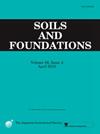上软下硬地层盾构隧道衬砌作用荷载及力学特性研究
IF 3.3
2区 工程技术
Q2 ENGINEERING, GEOLOGICAL
引用次数: 0
摘要
盾构隧道穿越上软下硬地层时,地质差异明显,导致管片衬砌应力分布不均匀,加剧了施工挑战和安全风险。研究此类地层中隧道衬砌的受力条件和力学特性是十分必要的。因此,在南昌地铁1号线的两个盾构隧道施工现场进行了现场测量,特别是在粉质粘土-砾石层和均匀砂层中。长时间监测了分段衬砌的作用荷载和内力。通过对监测数据的分析,总结了上软下硬地层中管片衬砌在施工阶段荷载的变化规律。并将实测载荷条件与理论解析解进行了对比分析。随后,进行了包含螺栓连接和螺栓预紧力的精细化数值模拟,以进一步探索管片衬砌的力学行为,并与测量的内力数据进行了比较。结果表明:盾构尾端同步注浆对上部软土层土压力影响显著,同步注浆引起的最大土压力约为最终稳定值的1.9倍;管片衬砌上部竖向土压力呈现“中间大、两端小”的特征,稳定后的实测最大值约为Terzaghi理论预测的理论值的72%。值得注意的是,在地层界面处观察到侧向土压力的突然变化。隧道段仰拱处的弯矩和轴力相对小于拱顶处。此外,在较低的硬地层中,段内内力的发展受到相当大的限制。本文章由计算机程序翻译,如有差异,请以英文原文为准。
Investigation of acting load and mechanical characteristics of shield tunnel lining in upper-soft and lower-hard stratum
When shield tunnels traverse the upper-soft and lower-hard stratum, the pronounced geological differences lead to uneven stress distribution on the segmental lining, thereby intensifying both construction challenges and safety risks. Investigating the loading conditions and mechanical characteristics of tunnel linings in such strata is imperative. Therefore, field measurements were conducted at two shield tunnel construction sites along Nanchang Metro Line 1, specifically within a silty clay-gravel layer and a homogeneous sand layer. The acting load and internal forces of the segmental lining were monitored over an extended period. By analyzing the monitoring data, the variation patterns of the loads acting on the segmental lining in the upper-soft and lower-hard stratum during the construction stage were summarized. Furthermore, a comparative analysis was carried out between the measured loading conditions and the theoretical analytical solutions. Subsequently, a refined numerical simulation incorporating bolt joints and bolt preload on the segment was performed to further explore the mechanical behavior of the segmental lining, with a comparison to the measured internal force data. The results indicate that synchronous grouting at the shield tail significantly affects the earth pressure in the upper soft soil layer, with the maximum earth pressure induced by synchronous grouting being approximately 1.9 times the final stable value. The vertical earth pressure in the upper part of the segmental lining exhibits a characteristic pattern of being “large in the middle and small at both ends”, with the measured maximum value after stabilization corresponding to approximately 72% of the theoretical value predicted by Terzaghi’s theory. Notably, a sudden change in lateral earth pressure is observed at the stratum interface. The bending moment and axial force at the invert of the tunnel segment are comparatively smaller than those at the vault. Additionally, the development of internal forces within the segment is fairly constrained in the lower hard stratum.
求助全文
通过发布文献求助,成功后即可免费获取论文全文。
去求助
来源期刊

Soils and Foundations
工程技术-地球科学综合
CiteScore
6.40
自引率
8.10%
发文量
99
审稿时长
5 months
期刊介绍:
Soils and Foundations is one of the leading journals in the field of soil mechanics and geotechnical engineering. It is the official journal of the Japanese Geotechnical Society (JGS)., The journal publishes a variety of original research paper, technical reports, technical notes, as well as the state-of-the-art reports upon invitation by the Editor, in the fields of soil and rock mechanics, geotechnical engineering, and environmental geotechnics. Since the publication of Volume 1, No.1 issue in June 1960, Soils and Foundations will celebrate the 60th anniversary in the year of 2020.
Soils and Foundations welcomes theoretical as well as practical work associated with the aforementioned field(s). Case studies that describe the original and interdisciplinary work applicable to geotechnical engineering are particularly encouraged. Discussions to each of the published articles are also welcomed in order to provide an avenue in which opinions of peers may be fed back or exchanged. In providing latest expertise on a specific topic, one issue out of six per year on average was allocated to include selected papers from the International Symposia which were held in Japan as well as overseas.
 求助内容:
求助内容: 应助结果提醒方式:
应助结果提醒方式:


